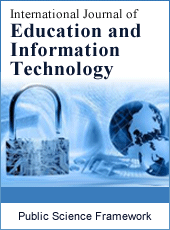International Journal of Education and Information Technology
Articles Information
International Journal of Education and Information Technology, Vol.3, No.3, Sep. 2018, Pub. Date: Aug. 10, 2018
Study on Effect of Voice Analysis Applying on Tone Training Software for Hearing Impaired People
Pages: 53-59 Views: 2111 Downloads: 476
[01]
Chia-Hui Feng, Department of Creative Product Design, Southern Taiwan University of Science and Technology, Tainan, Taiwan, R.O.C..
[02]
Yu-Yao Huang, Department of Creative Product Design, Southern Taiwan University of Science and Technology, Tainan, Taiwan, R.O.C..
[03]
Rain Chen, Department of Visual Communication Design, Southern Taiwan University of Science and Technology, Tainan, Taiwan, R.O.C..
According to the current oral training and necessity of the hearing impaired people, this study would develop mobile based tone training software for them. The withdrawal design (A-B-A design) of single-subject research designs has been applied for this study. The subjects of study are 4 hearing impaired university students. The software training has been applied for 3 successive days of baseline phase, 5 days of intervention phase and 3 days of maintenance phase. The result shows that: (1) the average level difference of the 4 subjects from baseline phase to intervention phase is +17.85 (subject A is +25.8%, subject B is +12.4%, subject C is +23.4%, and subject D is +9.8%). This shows that there has been positive effect to tone articulation of the 4 subjects. (2) The overlapped percentage of the 4 subjects from intervention phase to maintenance phase is 74.75% (subject A is 66%, subject B is 100%, subject C is 100%, and subject D is 33%). This shows that there has been maintenance effect for the tone articulation of the 4 subjects. (3) According to the result of the experiment, it has been verified that combining ocular feedback approach and mobile based software for oral training of the hearing impaired people have certain effects and prospects.
Hearing Impaired People, Oral Training, Voice Analysis, Withdrawal Design
[01]
Chaisanit, S. & Suksakulchai, S. (2014). The E-Learning Platform for Pronunciation Training for the Hearing-Impaired. International Journal of Multimedia and Ubiquitous Engineering, 9 (8), 377-388.
[02]
Chang, H. F., Gu, H. Y., & Wu, J. H. (2004). A Pilot Study on Human Listener Evaluation and Computerized Tone-Contour Analysis of Mandarin Disyllable Utterances by Hearing-Impaired Students. Bulletin of Special Education, 26, 221-245.
[03]
Chiang, Y. C. (2006). Learning Mandarin Lexical Tones in Written Forms by Deaf Adolescents: Using Speech Training Software with Visual Feedback Features. Bulletin of Special Education, 30, 95-111.
[04]
Chien, T. H. & Chen, S. Y. (2007). The Effect of Music Training on Mandarin Tone Intelligibility for Children with Hearing Impairments. Bulletin of Special Education, 32 (2), 93-114.
[05]
Ching, T. (1990). Tones for profoundly deaf tone-language speakers. Conference papers. ERIC Document Reproduction Service No. ED 335.
[06]
Ciocca, V., Francis, A. L., Aisha, R., & Wong, L. (2002). The perception of Cantonese lexical tones by early-deafened cochlear implantees. Journal of the Acoustical Society of America, 111 (5), 2250-2256.
[07]
Darrow, A. A. & Starmer, G. J. (1986). The effect of vocal training on the intonation and rate of hearing impaired children’s speech: A pilot study. Journal of Music Therapy, 23 (4), 194-201.
[08]
Domínguez, M., Latorre, I., Farrús, F., Codina-Filbà, J., & Wanner, L. (2016). Praat on the Web: An Upgrade of Praat for Semi-Automatic Speech Annotation. In Proceedings of the 25th International Conference on Computational Linguistics, Osaka, Japan.
[09]
Eriksson, E., Bälter, O., Engwall, O., Öster, A-M., & Sidenbladh-Kjellström, H. (2005). Design Recommendations for a Computer-Based Speech Training System Based on End-User Interviews. In: Proceedings of the Tenth International Conference on Speech and Computers, 483-486.
[10]
Grant, K. (1987). Identification of intonation contours by normally hearing and profoundly hearing-impaired listeners. Journal of the Acoustical Society of America, 82, 1172-1178.
[11]
Jheng, J. Y. (2001). How to improve students' oral communication ability. Special Education, 40, 9-14.
[12]
Lee, K. Y. S., van Hasselt, C. A., Chiu, S. N., & Cheung, D. M. (2002). Cantonese tone perception ability of cochlear implant children in comparison with normal-hearing children. International Journal of Pediatric Otorhinolaryngology, 63 (2), 137-147.
[13]
Li, J. Y. (2010). Language Teaching of Hearing Impaired Students. Special Education, 9901, 9-14.
[14]
Lin, B. G. (1994). Hearing Impaired Education and Rehabilitation, Taipei: Wunan Book Co., Ltd.
[15]
Wei, W. I., Wong R., Hui, Y., Au, D. K. K., Wong, B. Y. K., Ho, W. K., Tsang, A., Kung, P., & Chung E. (2000). Chinese tonal language rehabilitation following cochlear implantation in children. Acta Oto-Laryngol 2000, 120, 218-221.
[16]
Wong, A. O. & Wong, L. L. (2004). Tone perception of Cantonese-speaking prelingually hearing-impaired children with cochlear implants. Otolaryngol-Head Neck Surg, 130 (6), 751-758.
[17]
Zhou, N. & Xu, L. (2008). Development and evaluation of methods for assessing tone production skills in Mandarin-speaking children with cochlear implants. Journal of the Acoustical Society of America, 123 (3), 1653-1664.

ISSN Print: 2381-7410
ISSN Online: 2381-7429
Current Issue:
Vol. 5, Issue 1, March Submit a Manuscript Join Editorial Board Join Reviewer Team
ISSN Online: 2381-7429
Current Issue:
Vol. 5, Issue 1, March Submit a Manuscript Join Editorial Board Join Reviewer Team
| About This Journal |
| All Issues |
| Open Access |
| Indexing |
| Payment Information |
| Author Guidelines |
| Review Process |
| Publication Ethics |
| Editorial Board |
| Peer Reviewers |


